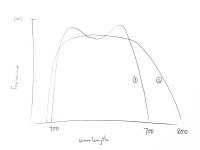kimmik
Well-known member

Two otherwise identical telescopes, but different transmission spectrum:

Spectrum 1 and 2 will have:
Perhaps binoculars/telescopes should have a CRI rating like lightbulbs. Colour rendering index, out of 100. Leica and Nikon will top the chart I suspect.
Going further, there could be several separate colour ratings:
Colour temperature
Colour rendering index
Gamut
Colour uniformity across the FOV
Colour uniformity with pupil alignment changes

Spectrum 1 and 2 will have:
- Similar brightness
- 2 will have faint yellow/green tint
- 1 will be more neutral, but less colour accuracy, like fluorescent light (neutral but less natural)
Perhaps binoculars/telescopes should have a CRI rating like lightbulbs. Colour rendering index, out of 100. Leica and Nikon will top the chart I suspect.
Going further, there could be several separate colour ratings:
Colour temperature
Colour rendering index
Gamut
Colour uniformity across the FOV
Colour uniformity with pupil alignment changes





